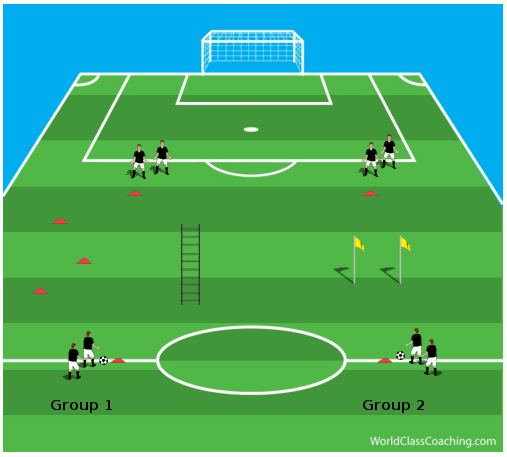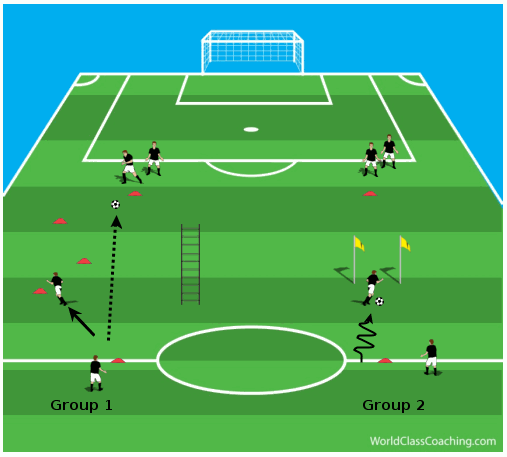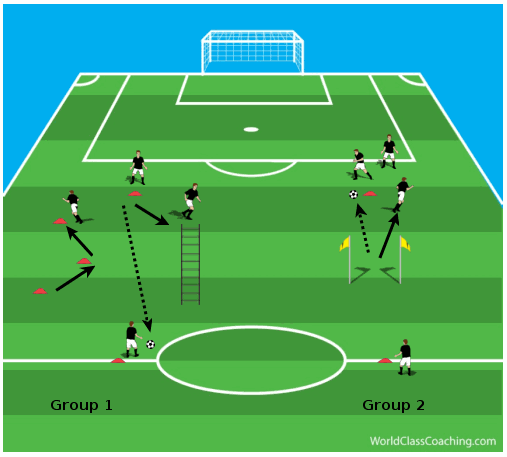By Justin Cresser
Today’s article focuses on developing anaerobic endurance, agility and to a lesser extent, speed over short distances. Because this activity incorporates more more than one component of conditioning, it is a great choice for in-season training sessions where more time is needed for small-sided games and match preparation, and less time can be devoted to fitness training.
This activity will use two different stations, as shown in Figure 1. Divide your squad into two equal groups. Group 1 will begin at Station 1 and Group 2 will begin at Station 2.
For Station 1 (shown on the left of Figure 1) place two small cones 20 yards apart. Have the players in group 1 stand behind these cones facing each other (equal numbers for each line). Place an agility ladder midway between the cones, but 5 yards to one side.
To the other side, set up three cones so that they are 3 yards apart. However, the middle cone should be offset from the other two by 3 yards (Figure 1).
For Station 2 (shown on the right of Figure 1) place two small cones 20 yards apart. Have the players in group 2 stand behind these cones facing each other (equal numbers for each line). Place two flags (or large cones) midway between these two cones. The flags should be 1 yard apart.

For station 1, play is initiated by the first player in the line at the bottom taking a touch out of their feet and then playing a pass to the player at the front of the line at the top. As soon as they make this pass, they should sprint towards the cone to their left, make a cut and then accelerate towards the cone 3 yards to their right. At this cone, they again perform a cut and then sprint towards the third cone, where they make one final cut and then run towards the back of the line at the top (Figures 2 and 3).
The player at the top receiving the ball should take a touch and then play a pass to the feet of the player at the front of the line at the bottom (Figure 3). As soon as they make this pass, they should sprint towards and then run through the agility ladder using a one foot per square pattern. After completing the ladder, they should join the back of the line at the bottom.
For station 2, play is initiated by the first player in the line at the bottom speed dribbling towards the flags (Figure 2). As soon as they reach the flags, they should play a pass to the feet of the player at the front of the line at the top and then sprint towards the end of this line (Figure 3). The player who receives the pass then does the same thing.
Have both groups work for 2 minutes and then switch stations. Continue this process until both groups have performed 2 or 3 sets at each station. However, ensure the players rest for 90 seconds to 2 minutes between each set.
COACHING POINTS:
- Ensure the players are making quality (good weight and accurate) passes.
- Encourage them to accelerate as quickly as possible after making their pass
- When running through the ladder, the players should use good foot footwork but move as quickly as possible. Foot contact in each square should be rapid and lite
- Ensure the players accelerate between the 3 cones as quickly as possible and use good cutting technique. They should also maintain good posture (low centre of gravity and slight forward lean)
- The players should dribble as quickly as possible towards the flags, but under control. Contact with the ball should be with the laces and the toe should be pointing down with the heel up
- This exercise is meant to be performed at a high intensity, so encourage a high work rate from the players
VARIATION:
You can progress or vary this exercise in several ways. You can have the players in the top line at station 1 perform a more complex pattern when they are running through the agility ladder. For the players in the bottom line, you can instruct them to sprint to the first cone and then backpedal or side shuffle to the second and then third cones (Figure 4).
For the players at station 2; you can have them dribble to the flags, make a pass, and then backpedal as quickly as possible until they return to their initial position (Figure 4). You can also have them perform a skill such as a step-over while dribbling.
For the passing component, you can vary the way the players make the pass (one touch, driven with the laces instead of the inside of the foot) or you can vary the way they receive the ball with their first touch (inside or outside of the foot).
Best of Luck,
Justin.
Justin Cresser – Has coached soccer at various levels both in North America and abroad (Hong Kong and Africa). His most recent position was as the Assistant Technical Director at the Soccer Club of Toronto. He has his National Diploma from the NSCAA and is also a certified strength and conditioning coach.





